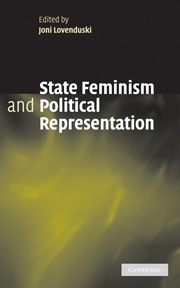Book contents
- Frontmatter
- Contents
- List of figures
- List of tables
- Notes on contributors
- Preface
- List of abbreviations
- 1 Introduction: state feminism and the political representation of women
- 2 Gendering political representation: debates and controversies in Austria
- 3 The Belgian paradox: inclusion and exclusion of gender issues
- 4 A politics for presence: state feminism, women's movements and political representation in Finland
- 5 Gendering the republican system: debates on women's political representation in France
- 6 WPAs and political representation in Germany
- 7 Gendering the debate on political representation in Italy: a difficult challenge
- 8 High tides in a low country: gendering political representation in the Netherlands
- 9 The women's movement, gender equality agencies and central-state debates on political representation in Spain
- 10 Party feminism, state feminism and women's representation in Sweden
- 11 Party government and women's representation debates: the UK
- 12 Women's policy agencies, the women's movement and representation in the USA
- 13 Conclusions: state feminism and political representation
- Appendix 1 Tables of women's representation in eleven countries
- Appendix 2 The RNGS model: summary of variable descriptors
- Index
- References
8 - High tides in a low country: gendering political representation in the Netherlands
Published online by Cambridge University Press: 22 September 2009
- Frontmatter
- Contents
- List of figures
- List of tables
- Notes on contributors
- Preface
- List of abbreviations
- 1 Introduction: state feminism and the political representation of women
- 2 Gendering political representation: debates and controversies in Austria
- 3 The Belgian paradox: inclusion and exclusion of gender issues
- 4 A politics for presence: state feminism, women's movements and political representation in Finland
- 5 Gendering the republican system: debates on women's political representation in France
- 6 WPAs and political representation in Germany
- 7 Gendering the debate on political representation in Italy: a difficult challenge
- 8 High tides in a low country: gendering political representation in the Netherlands
- 9 The women's movement, gender equality agencies and central-state debates on political representation in Spain
- 10 Party feminism, state feminism and women's representation in Sweden
- 11 Party government and women's representation debates: the UK
- 12 Women's policy agencies, the women's movement and representation in the USA
- 13 Conclusions: state feminism and political representation
- Appendix 1 Tables of women's representation in eleven countries
- Appendix 2 The RNGS model: summary of variable descriptors
- Index
- References
Summary
Introduction
The right to be represented was a central issue in the Dutch war of independence (1568–1648) that resulted in the Republic of the Seven United Provinces. The Netherlands, including Belgium, became a centralised kingdom in 1813 after the Napoleonic occupation; in 1830, however, the Belgians revolted to become an independent kingdom. The basic rules for representative government were formulated in 1848; in 1917 universal suffrage, male and female, was won. The Dutch political system is based on proportional representation; the most important legislative body is the second chamber, the first chamber having limited powers. A multi-party system makes coalition governments a permanent feature; political parties are key actors in the policy process.
Until the 1960s the political system was remarkably stable; Dutch political parties followed the fault lines of society, forming Catholic, Protestant and Social Democratic ‘pillars’. An extensive system of corporatist ‘advisory boards’ played an important role in the ‘consensus democracy’, providing institutionalised access to the policy-making process mainly for business and professional interests and labour unions belonging to the three pillars (Andeweg and Irwin 1993).
From the 1960s onwards, when ‘new’ social movements demanded more ‘democracy’, representation was regularly on the agenda in three types of arenas: in the media, political parties and parliament. A new political party, D66, demanding a more confrontational style of politics, entered parliament with seven members in 1966. The women's movement was another important factor.
- Type
- Chapter
- Information
- State Feminism and Political Representation , pp. 153 - 173Publisher: Cambridge University PressPrint publication year: 2005
References
- 2
- Cited by



